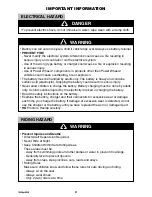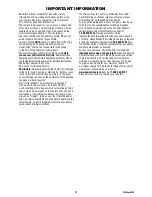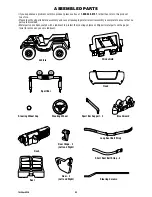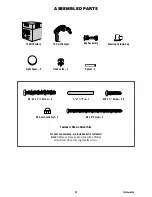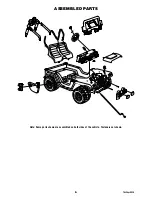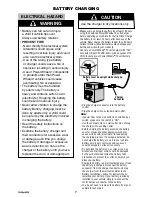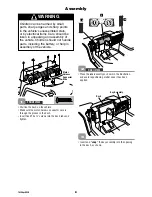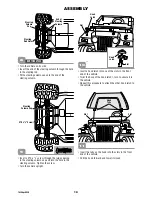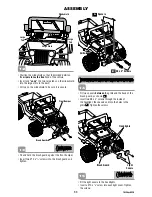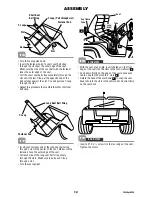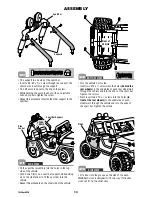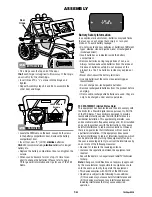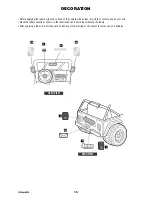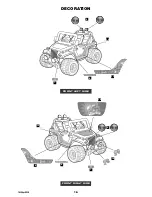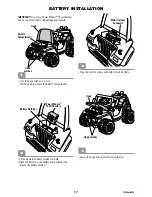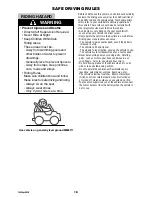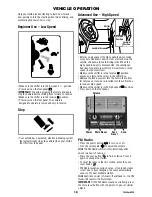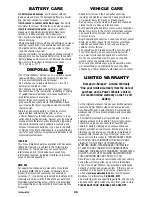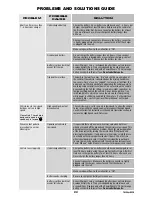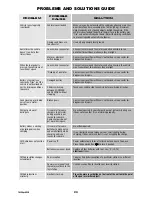
14
T8396pr-0920
ASSEMBLY
Door
Hinge
• Fit a hinge over the top end of the door.
Hint:
Each hinge is designed to fit one way. If the hinge
does not fit, try the other hinge.
• Insert three #10 x
3
/
4
" screws into the hinge and
tighten.
• Repeat Assembly steps 23 and 24 to assemble the
other door and hinge.
BOTTOM VIEW
24
Battery Safety Information
In exceptional circumstances, batteries may leak fluids
that can cause a chemical burn injury or ruin your
product. To avoid battery leakage:
• Do not mix old and new batteries or batteries of different
types: alkaline, standard (carbon-zinc) or rechargeable
(nickel-cadmium).
• Insert batteries as indicated inside the battery
compartment.
• Remove batteries during long periods of non-use.
Always remove exhausted batteries from the product.
Dispose of batteries safely. Do not dispose of the
product in a fire. The batteries inside may explode or
leak.
• Never short-circuit the battery terminals.
• Use only batteries of the same or equivalent type, as
recommended.
• Do not charge non-rechargeable batteries.
• Remove rechargeable batteries from the product before
charging.
• If removable, rechargeable batteries are used, they are
only to be charged under adult supervision.
1.5V x 4
"C" (LR14)
• Locate the FM Radio on the dash. Loosen both screws
in the battery compartment door. Remove the battery
compartment door.
• Insert four, new "C" (LR14)
alkaline
batteries.
Hint:
We recommend using
alkaline
batteries for longer
battery life.
• Replace the battery compartment door and tighten the
screws.
• When sounds become faint or stop, it’s time for an
adult to change the batteries! Please refer to page
19 for general information and tips for use of the FM
Radio.
Loosen These
Screws
DASH VIEW
25
FCC STATEMENT (United States Only)
This equipment has been tested and found to comply with
the limits for a Class B digital device, pursuant to Part 15
of the FCC Rules. These limits are designed to provide
reasonable protection against harmful interference in a
residential installation. This equipment generates, uses
and can radiate radio frequency energy and, if not installed
and used in accordance with the instructions, may cause
harmful interference to radio communications. However,
there is no guarantee that interference will not occur in
a particular installation. If this equipment does cause
harmful interference to radio or television reception, which
can be determined by turning the equipment off and on,
the user is encouraged to try to correct the interference by
one or more of the following measures:
• Reorient or relocate the receiving antenna.
• Increase the separation between the equipment and
receiver.
• Consult the dealer or an experienced radio/TV technician
for help.
Note:
Changes or modifications not expressly approved
by the manufacturer responsible for compliance could
void the user’s authority to operate the equipment.
• This device complies with Part 15 of the FCC Rules.
• Operation is subject to the following two conditions:
(1) this device may not cause harmful interference and
(2) this device must accept any interference received,
including interference that may cause undesired
operation.


